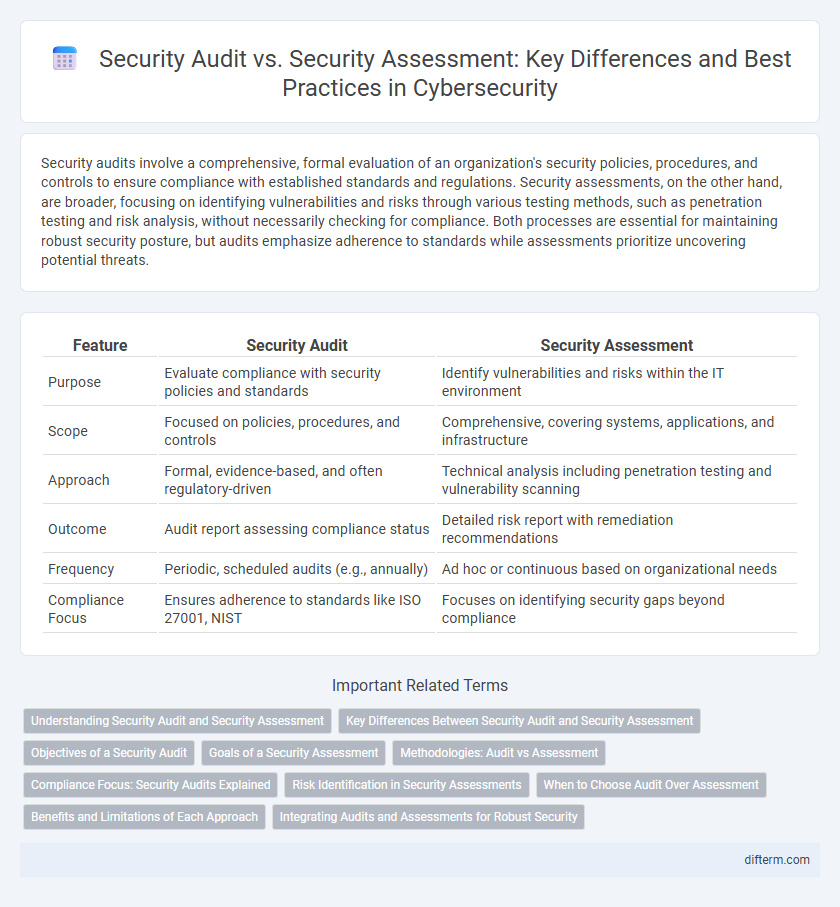Security audits involve a comprehensive, formal evaluation of an organization's security policies, procedures, and controls to ensure compliance with established standards and regulations. Security assessments, on the other hand, are broader, focusing on identifying vulnerabilities and risks through various testing methods, such as penetration testing and risk analysis, without necessarily checking for compliance. Both processes are essential for maintaining robust security posture, but audits emphasize adherence to standards while assessments prioritize uncovering potential threats.
Table of Comparison
| Feature | Security Audit | Security Assessment |
|---|---|---|
| Purpose | Evaluate compliance with security policies and standards | Identify vulnerabilities and risks within the IT environment |
| Scope | Focused on policies, procedures, and controls | Comprehensive, covering systems, applications, and infrastructure |
| Approach | Formal, evidence-based, and often regulatory-driven | Technical analysis including penetration testing and vulnerability scanning |
| Outcome | Audit report assessing compliance status | Detailed risk report with remediation recommendations |
| Frequency | Periodic, scheduled audits (e.g., annually) | Ad hoc or continuous based on organizational needs |
| Compliance Focus | Ensures adherence to standards like ISO 27001, NIST | Focuses on identifying security gaps beyond compliance |
Understanding Security Audit and Security Assessment
Security audit involves a systematic evaluation of an organization's information systems, policies, and controls to ensure compliance with regulatory standards and internal security requirements. Security assessment focuses on identifying vulnerabilities and risks within the IT infrastructure by analyzing potential threats and weaknesses that could be exploited by attackers. Both methods are essential for maintaining robust cybersecurity frameworks, but audits emphasize compliance verification while assessments prioritize risk identification and mitigation strategies.
Key Differences Between Security Audit and Security Assessment
Security audits are formal, systematic evaluations of an organization's security policies, controls, and compliance with regulatory standards, often conducted by external auditors. Security assessments provide a broader, more flexible analysis of an organization's security posture, identifying vulnerabilities, risks, and mitigation strategies through various testing methods such as penetration testing and risk analysis. The key differences lie in the audit's focus on compliance and documentation versus the assessment's emphasis on identifying and addressing security weaknesses.
Objectives of a Security Audit
A Security Audit aims to systematically evaluate an organization's security policies, controls, and compliance with established standards such as ISO 27001 or PCI DSS. The primary objectives include verifying adherence to security frameworks, identifying vulnerabilities, and ensuring that risk management practices are effectively implemented. Security Audits provide documented evidence of security posture, enabling organizations to address gaps and improve their overall cybersecurity resilience.
Goals of a Security Assessment
A security assessment aims to identify vulnerabilities, evaluate security controls, and measure the effectiveness of an organization's overall security posture. It systematically analyzes risks by testing policies, procedures, and technical safeguards to ensure compliance and resilience against threats. The goal is to provide actionable insights that guide the implementation of stronger security measures and reduce the attack surface.
Methodologies: Audit vs Assessment
Security audits follow a formal, checklist-driven methodology emphasizing compliance with established standards such as ISO 27001 or NIST, ensuring documented controls meet regulatory requirements. Security assessments employ a broader, flexible approach integrating risk analysis, vulnerability scanning, and threat modeling to identify potential weaknesses beyond compliance. Both methodologies contribute to organizational security by systematically evaluating controls; audits validate adherence while assessments uncover practical security gaps.
Compliance Focus: Security Audits Explained
Security audits emphasize compliance by systematically evaluating an organization's adherence to established security policies, standards, and regulatory requirements such as GDPR or HIPAA. These audits involve thorough documentation reviews, policy verification, and control assessments to ensure all security measures meet mandatory compliance criteria. Security assessments, while broader in scope, may identify vulnerabilities but lack the stringent compliance verification central to security audits.
Risk Identification in Security Assessments
Security assessments prioritize risk identification by systematically evaluating vulnerabilities, potential threats, and the likelihood of exploitation within an organization's environment. Unlike security audits, which primarily focus on compliance with established standards and policies, security assessments provide a proactive approach to uncovering hidden risks and weaknesses. This process enables organizations to implement targeted mitigation strategies, enhancing overall security posture and resilience against cyber threats.
When to Choose Audit Over Assessment
Choose a security audit over a security assessment when compliance with specific regulatory standards or certifications, such as ISO 27001 or PCI DSS, is required. Security audits provide a detailed, formal evaluation with documented evidence essential for legal or organizational accountability. Opt for audits when an organization needs to validate the effectiveness of existing controls and demonstrate adherence to mandated security policies.
Benefits and Limitations of Each Approach
Security audits provide a comprehensive evaluation of an organization's adherence to established policies and regulatory requirements, offering detailed compliance reports but often requiring significant time and resources. Security assessments, in contrast, focus on identifying vulnerabilities and risks through targeted testing and analysis, allowing for quicker remediation but potentially missing broader compliance issues. Both approaches complement each other by balancing thorough compliance verification with proactive risk detection, though relying solely on one may leave gaps in organizational security posture.
Integrating Audits and Assessments for Robust Security
Integrating security audits and security assessments enhances the overall security posture by combining the thorough compliance checks of audits with the vulnerability identification capabilities of assessments. Security audits focus on verifying adherence to established policies and regulations, while security assessments evaluate potential threats and system weaknesses proactively. A unified approach ensures continuous monitoring, risk mitigation, and comprehensive protection against evolving cyber threats.
Security Audit vs Security Assessment Infographic

 difterm.com
difterm.com